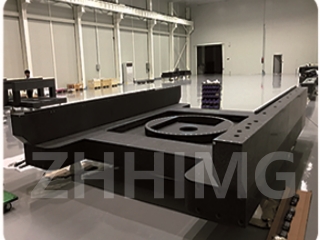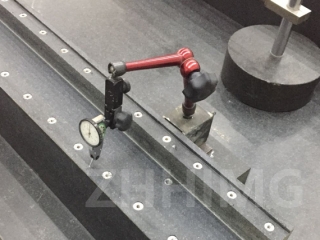In the field of precision manufacturing, laser 3D measuring instruments, with their advantages of high precision and high efficiency in measurement, have become key equipment for quality control and product research and development. As the core supporting component of the measuring instrument, the material selection of the base has a profound impact on the measurement accuracy, stability and long-term usage cost. This article will deeply analyze the cost differences when the base of the laser 3D measuring instrument is made of cast iron and granite.
Procurement cost: Cast iron has an advantage in the initial stage
Cast iron bases have a distinct price advantage in the procurement process. Due to the wide availability of cast iron materials and the mature processing technology, its manufacturing cost is relatively low. The purchase price of a common specification cast iron base may only be a few thousand yuan. For instance, the market price of a regular-sized cast iron laser 3D measuring instrument base with average precision requirements is approximately 3,000 to 5,000 yuan. Granite bases, due to the difficulty in extracting raw materials and the higher requirements for equipment and technology during the processing, often have a procurement cost that is 2 to 3 times that of cast iron bases. The price of high-quality granite bases may range from 10,000 to 15,000 yuan, which makes many enterprises with limited budgets more inclined to choose cast iron bases when making their first purchase.

Maintenance cost: Granite saves more in the long run
During long-term use, the maintenance cost of cast iron bases has gradually become prominent. The coefficient of thermal expansion of cast iron is relatively high, around 11-12 ×10⁻⁶/℃. When the working environment temperature of the measuring instrument fluctuates greatly, the cast iron base is prone to thermal deformation, resulting in a decrease in measurement accuracy. To ensure measurement accuracy, it is necessary to calibrate the measuring instrument regularly. The calibration frequency may be as high as once a quarter or even once a month, and the cost of each calibration is approximately 500 to 1,000 yuan. In addition, cast iron bases are prone to corrosion. In damp or corrosive gas environments, additional anti-rust treatment is required, and the annual maintenance cost may reach 1,000 to 2,000 yuan.
In contrast, the granite base has an extremely low coefficient of thermal expansion, only 5-7 ×10⁻⁶/℃, and is minimally affected by temperature. It can maintain a stable measurement reference even after long-term use. It has high hardness, with a Mohs hardness of 6-7, strong wear resistance, and its surface is not prone to wear, reducing the frequency of calibration due to precision decline. Usually, 1-2 calibrations per year are sufficient. Moreover, granite has stable chemical properties and is not easily corroded. It does not require frequent maintenance operations such as rust prevention, which greatly reduces the long-term maintenance cost.
Service life: Granite far exceeds cast iron
Due to the material properties of cast iron bases, during long-term use, they are affected by factors such as vibration, wear and corrosion, and their internal structure gradually gets damaged, resulting in a decline in precision and a relatively short service life. Under normal circumstances, the service life of a cast iron base is about 5 to 8 years. When the service life is reached, to ensure measurement accuracy, enterprises need to replace the base with a new one, which adds another new procurement cost.
Granite bases, with their dense and uniform internal structure and excellent physical properties, have a longer service life. Under normal usage conditions, the service life of a granite base can reach 15 to 20 years. Although the initial procurement cost is high, from the perspective of the entire life cycle of the equipment, the number of replacements is reduced, and the annual cost is actually lower.
Taking into account multiple factors such as procurement cost, maintenance cost and service life, although cast iron bases are low in price at the initial purchase stage, the high maintenance cost and relatively short service life during long-term use make their overall cost not advantageous. Although the granite base requires a large initial investment, it can demonstrate higher cost-effectiveness over long-term use due to its stable performance, low maintenance cost and extremely long service life. For laser 3D measuring instrument application scenarios that pursue high precision and long-term stable operation, choosing a granite base is a more cost-effective decision, which helps enterprises reduce comprehensive costs, improve production efficiency and product quality.
Post time: May-13-2025

